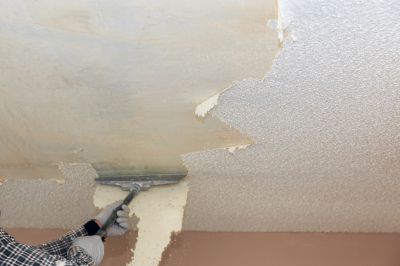Popular Solutions For Effective Popcorn Ceiling Removal Projects
Explore a range of reliable products that simplify the process of removing popcorn ceilings with professional-quality results.
 Removing popcorn ceilings can be a challenging yet manageable DIY project or one best suited for professional contractors. The process typically involves wetting the textured surface to loosen the material and then scraping it off carefully to avoid damaging the underlying ceiling. Safety precautions are essential, especially when dealing with older textures that may contain asbestos; testing for hazardous materials beforehand is highly recommended. A variety of products are available to facilitate this process, from specialized scrapers to protective gear and removal kits. Proper preparation, including covering furniture and floors, can help minimize mess and ensure a smoother removal experience.
Removing popcorn ceilings can be a challenging yet manageable DIY project or one best suited for professional contractors. The process typically involves wetting the textured surface to loosen the material and then scraping it off carefully to avoid damaging the underlying ceiling. Safety precautions are essential, especially when dealing with older textures that may contain asbestos; testing for hazardous materials beforehand is highly recommended. A variety of products are available to facilitate this process, from specialized scrapers to protective gear and removal kits. Proper preparation, including covering furniture and floors, can help minimize mess and ensure a smoother removal experience.
Top Overall Option
Multi-Purpose Ceiling Removal Kit
A comprehensive ceiling removal kit that includes durable scrapers, protective gear, and water spray bottles offers versatility for various popcorn ceiling removal projects. Designed to accommodate different ceiling textures and sizes, this all-in-one solution can help streamline the process while maintaining safety. Its ergonomic tools and included accessories make it suitable for both DIY enthusiasts and professional contractors aiming for efficient results.
Types of Products For Popcorn Ceiling Removals
Heavy-Duty Ceiling Scrapers
Sturdy scrapers with ergonomic handles designed to safely remove popcorn texture without damaging the ceiling surface.
Spray Bottles and Water Dispensers
Essential for applying water or removal solutions evenly across textured ceilings to loosen materials before scraping.
Chemical Softening Solutions
Specialized liquids formulated to soften popcorn textures, making removal easier and reducing the need for excessive scraping.
Protective Gear Sets
Includes masks, goggles, and coveralls to ensure safety from dust and debris during removal.
Extension Poles for Scrapers
Extendable handles that allow for reaching high ceilings comfortably and safely without ladders.
Dust Containment Systems
Enclosures or plastic sheeting designed to contain dust and debris, minimizing mess during removal.
Patching and Sanding Kits
Tools and compounds for repairing and smoothing the ceiling surface after popcorn removal.
Heat Guns
Devices that apply controlled heat to soften popcorn textures, aiding in removal in sensitive areas.
Floor and Furniture Coverings
Protective coverings to shield surfaces from water, dust, and debris during the removal process.
Professional Removal Systems
Advanced tools designed for large-scale or commercial popcorn ceiling removal projects, often used by contractors.
Popular Choices
Complete kits that include various tools and safety gear, suitable for DIY projects of different sizes.
Robust scrapers designed to handle tough textures and large areas efficiently.
Widely used for their ease of application when loosening popcorn textures.
Common safety items essential for protecting against dust and debris during removal.
Popular for containing dust and simplifying cleanup during the removal process.
Frequently used for repairing and smoothing ceilings after popcorn removal.
Trusted for reaching high ceilings safely and comfortably.
Chosen by many for their ability to soften textures in difficult areas.
Commonly used to protect surfaces from water and debris during removal.
Popular for their effectiveness in loosening popcorn textures with minimal effort.
For those undertaking the removal themselves, choosing the right tools is crucial. Heavy-duty scrapers with ergonomic handles can make the job easier and reduce fatigue. Spray bottles or garden sprayers are commonly used to apply water or removal solutions evenly across the textured surface. For more delicate ceilings or areas with intricate details, softer tools or even professional-grade removal systems might be necessary. After the popcorn texture is removed, additional steps such as sanding, patching, and repainting are often required to achieve a clean, finished look. Ensuring safety and using appropriate products can make the entire process more efficient and less stressful.
In addition to manual tools, there are specialized removal kits that combine multiple items needed for the task. These kits often include scrapers, protective gear, and sometimes even chemical solutions designed to soften the texture. When selecting products, consider the size of the area, the type of popcorn texture, and any underlying surface conditions. Proper ventilation and protective equipment are vital to prevent inhalation of dust or debris. Whether opting for a DIY approach or hiring professionals, understanding the available products and their applications can help in planning a successful popcorn ceiling removal project.
Key Buying Considerations
- Ceiling texture type and thickness to determine suitable removal tools.
- Presence of asbestos or hazardous materials in older popcorn ceilings; testing is essential before removal.
- Area size to estimate the quantity of supplies needed and whether professional help is advisable.
- Safety equipment such as masks, goggles, and protective clothing to prevent inhalation and contact with debris.
- Ease of use and ergonomic design of tools to reduce fatigue during extended projects.
- Compatibility of tools with high ceilings, including extension poles or scaffolding options.
- Dust containment features to minimize mess and facilitate cleanup.
- Type of removal method preferred, such as water-based softening or heat application.
- Surface condition of the ceiling after removal, including the need for patching or sanding.
- Budget considerations and whether investing in a comprehensive kit offers better value.
- Time constraints and project scope to decide between DIY or professional services.
- Availability of replacement parts or additional accessories for tools and kits.
- User reviews and ratings to gauge product effectiveness and reliability.
- Environmental safety standards related to chemical solutions or removal methods used.
